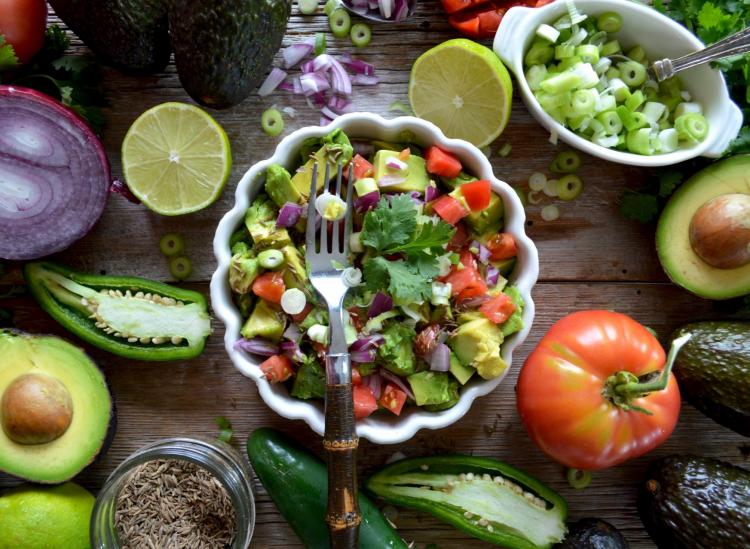Here Are The Most Popular Versions Of The Keto Diet

Unsplash/Nadine Primeau
The keto diet is becoming more popular than ever, but that doesn’t mean going keto looks the same for everyone. While each ketogenic plan shares a couple of standards, such as eating fewer than 50 grams of carbohydrates each day and scoring 80 percent of your daily calories from fat sources, there are several different types of keto diets that are each designed for specific goals and needs. And knowing about these different versions of keto can help you get the most out of your diet journey.
First things first, what is a ketogenic diet?
A ketogenic diet is a low-carb, high-fat and adequate-protein diet. This diet puts the body in ketosis, a metabolic state in which most of your energy comes from fat instead of glucose (metabolized carbs). When you are in ketosis, your liver is breaking down fat to make ketones, molecules that fuel the brain, muscles and heart when glucose is not available.
So, what can you eat on a keto diet? Usually, you have to stick to fewer than 50 grams of carbs daily that come from low-carb sources. Your protein intake also needs to be within moderate limits because your body can convert it into glucose (via gluconeogenesis). Most of your energy and nutrients come from fat on this diet, meaning 60 to 80 percent of your daily calories should come from real foods like butter, avocado, fatty fish and nuts.
However, this approach is not set in stone. Many keto dieters have tweaked their diets, still maintained ketosis and even benefited from the slight changes.

Types Of Ketogenic Diets: Knowing The Differences
There are dozens of different versions of the keto diet. Consider the four versions below, which are among the most popular and most effective.
1. Standard Ketogenic Diet (SKD)
This is the classic version of keto we discussed earlier. It’s the most often discussed — when you’re hearing about the keto diet, it’s probably about the SKD. SKD is suitable for beginners and anyone who wants to lose weight in a short span of time. This version of keto requires that:
- You consume only 20 to 50 grams of carbs per day, carbs making up 5 to 10 percent of your total calories.
- You eat 0.8 grams of protein per pound of lean body mass (or just eat proteins in moderation) per day.
- On average, 70 to 75 percent of your total calories should come from fat per day.
When starting a keto diet, your best bet is to go with this classic plan. It’s the most studied version of keto, with research showing health benefits beyond weight loss like reduced risk of heart disease and cancer, diabetes control, and improved cognitive function.
2. Cyclical Ketogenic Diet (CKD)
The CKD involves cycling between low-carb and high-carb eating. More specifically, the diet involves eating as you would on an SKD for five to six days followed by one to two days of eating a higher carb diet. The diet is divided into the ketogenic phase and the carb-loading phase. During the carb-loading phase, up to 70 percent of your calories should come from carbohydrates. This diet is favored among athletes who use it to boost their muscle glycogen levels, which helps them maintain their workout intensity and aid in their recovery. The CKD may also be useful for bodybuilders since it helps boost insulin levels, and insulin is an important anabolic hormone.
3. Targeted Ketogenic Diet (TKD)
The TKD involves eating carbs during specific times of the day, usually around workouts. Those on a TKD typically eat 20 to 50 grams of carbohydrates 30 minutes to an hour before or after their workouts. This amount is their total carb allowance for the day, meaning that they can only eat fat or protein during other times of the day. The goal of the TKD is to have more energy during workouts since muscles are believed to work best on glucose rather than fat or ketones. The TKD is often seen as a combination of the SKD and the CKD. The TKD is best for athletes who are starting a keto diet and have not yet become keto-adapted. Once keto-adapted, athletes are able to fully utilize ketones and fat during workouts, according to research.
4. High-Protein Ketogenic Diet (HKD)
The HKD is similar to the SKD, but with a greater intake of protein. On this version of keto, 60 percent of your calories come from fat, 35 percent of your calories come from protein and 5 percent of your calories come from carbohydrates. On average, that means you’re eating up to 1.5 grams of protein per pound of lean body mass, compared to only 0.8 grams on the SKD. This version of keto is great for bodybuilders whose bodies are very likely to use the extra protein for bulking up instead of converting it into glucose. The extra protein on this diet also helps curb hunger more effectively.

Other Types Of Ketogenic Diets
Apart from the four main types of keto mentioned above, there are two more versions of keto that aren’t as well known.
5. Dirty Keto Diet
Dirty keto is essentially your standard keto diet that doesn’t involve clean eating (or paying attention to food quality). The theory behind dirty keto is that as long as you’re hitting your macros, you’re set. A good example of a dirty keto meal would be eating bunless burgers from a fast food chain instead of a homemade chicken salad with avocado. This version of keto may very likely put you in ketosis and help you lose weight, but it may not be good for you when it comes to giving your body the proper nutrition it needs (like vitamins, minerals and fiber) and avoiding inflammation.
6. Lazy Keto Diet
It can seem like starting the keto diet requires a lot of learning, time and effort. Not everyone has the energy to do all of that so, instead, they rely on a lazy keto diet and hope for the best. Lazy keto is basically your college student’s take on keto, eating whatever you have in your fridge or pantry as long as it fits your macros. That can mean eating things like pasta, sugar, frozen meals and pizza. Like dirty keto, this lax take on keto can help you lose weight, but it’s not really good for your health.
The Bottom Line
Not everyone wants to go the usual route with keto. Some dieters, like bodybuilders and athletes, have special requirements and the classic keto approach may not work for them
Sofia Norton is the dietitian expert behind kissmyketo.com.
Sign up for Daily Fit by Swirled, our newsletter featuring a wellness tip of the day and must-read health news from around the web! You’ll be one step closer to living a healthy, balanced life.
RELATED
This Is How To Tell If You’re In Ketosis
This Is What A Vegan Keto Diet Looks Like
The Keto Diet Done Right Can Boost Your Skin Health In Major Ways











